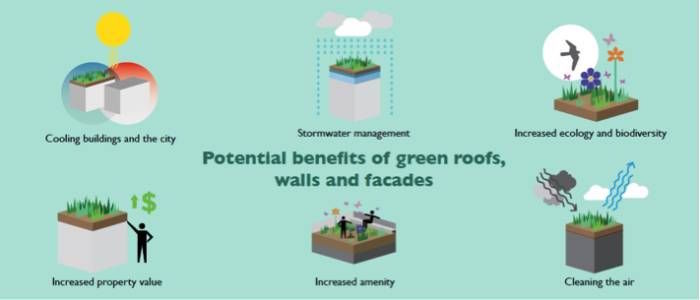Can you cut 1 Tonne of carbon pollution out of your life?
Take the challengeCongrats to the folks behind the Growing Green Guide for picking up the education award at the 2015 Premiers Sustainability Awards for Victoria. Developed by the University of Melbourne in partnership with Inner Melbourne Action Plan and the State Government, the guide is a must-read for anyone looking to create a green wall, roof or facade. The guide is even available as a free download so you can fill your head with all kinds of knowledge at the click of a button. Find it through the Growing Green Guide website here.
Benefits of green buildings:
Stumbling upon a green wall whilst exploring a city is a real gem, but apart from the obvious aesthetic benefits, there are so many more reasons why green buildings just make sense. Here's a few reasons outlined by the Growing Green Guide as to why green buildings are the go:

Source: The University of Melbourne | Pursuit
1 | Increase the value of property
Installing a green wall or rooftop terrace can give the property an edge over the competition and make property values bloom. There is so much unused potential for rooftop gardens and green walls and with the right planning, you could turn your building into a local landmark. Green roofs also make for very durable surfaces, protecting from solar radiation and adding insulation through vegetation and soil substrate.
2 | They help to manage rainwater
By absorbing rainwater, green roofs retain and maintain stormwater runoff and can help filter out any pollutants. Water can be stored in and evaporate from the substrate or foliage of the plants, reducing the amount of water ending up in the stormwater system.
3 | They're great for insulation and environmentally-friendly temperature control
Especially during hotter months, green roofs, walls and facades can shade the surface of the building, reducing the amount of heat absorption so that there is less of a need to turn on air conditioning, therefore saving on carbon emissions.
4 | Creating cooler cities
Whilst concrete, brick and glass collect the sun's heat and radiate it slowly back into the atmosphere, shading a surface with vegetation instead provides cooling effects when water is evaporated from the soil and plants, lowering surrounding temperatures in the process. If this were to happen on on a city-wide scale, the negative consequences of urban heat islands could be greatly reduced.
5 | They help to protect animals' habitats, as well as biodiversity
Green roofs can provide a home for different species of wildlife and plants, providing a safe haven for birds during migration. Bonus: you can go birdwatching from your window!
6 | They provide a breath of fresh air
Plants with high foliage density or textured leaf surfaces are better at trapping and removing small, particulate pollutants from the air. Air quality can be enhanced both indoors and outdoors through large-scale greenery implementation, which can help reduce heat and associated photochemical pollutants that are produced at higher temperatures.
See this list of The Best Plants to Purify the Air
7 | They look amazing
Face it, a space that is alive with an abundance of blooming plants and fauna is hands-down awesome to look at! Designing spaces with (quite literally) room for growth increases amenity and provides the opportunity to grow food or create beautiful spaces for commercial ventures.8 | Cities that embrace green open spaces are likely to be happier cities
It's a scientific fact! A study by the University of Exeter showed that living in areas with lots of green space impacts the overall wellbeing of those who live nearby, significantly lowering stress and contributing to higher life satisfaction.
Melbournians, you may be the most liveable city and know how to write an impressive guide to growing green roofs, walls and facades, but don't think us Sydney-siders don't know how to grow a mean green wall too. Check out our post on some incredible green building designs by Junglefy, the folks behind projects such as One Central Park:
We can't get enough of these amazing green spaces, so here's some more images we have found to further spark your inspiration:

Source: Garry Belinsky | Design Boom

Source: Danna | Curious Tangles

Source: The Snap Assembly

Source: Paolo Rosa
Header image: The Snap Assembly
READ THIS NEXT: 1 Million Women's guide to sustainable building materials

